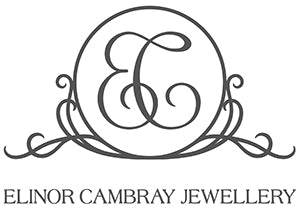
Your guide to diamonds and gemstones
Diamonds
Diamonds are hugely popular due to their beautiful sparkle and ‘brilliance’ and unrivalled hardness and durability. They have a refractive index of 2.417 to 2.419, and a hardness of 10 on the Mohs hardness scale, making them the hardest gemstone.
All diamonds are sourced from ethical and sustainable suppliers to ensure no exploitation such as child labour and dangerous mines are involved.
Diamonds are graded by their clarity, colour, cut and carat - known as the 4 Cs. Most diamonds are graded and certified by GIA - the Gemmological Institute of America.
Clarity
The GIA clarity scale has eleven clarity grades ranging from F (Flawless) to I3 (Included 3). Diamonds are formed under extreme heat and pressure, so it is very rare for a diamond to lack any inclusions. These natural inclusions and characteristics are used to identify natural diamonds and distinguish them from synthetics and simulants.
Most diamonds used in our jewellery are very slightly included VS1 and VS2.

Colour
The GIA colour scale ranges from D (colourless) to Z (light yellow / brown). Truly colourless diamonds are very rare. The colour of a diamond is determined by comparing it to a master set. Some diamonds also emit fluorescence when exposed to ultra-violet radiation. This does not affect the colour of the diamond, but the strength and colour of the fluorescence is recorded in GIA reports as it can help to identify them. Most diamonds used in our jewellery are near colourless G.

Cut
The GIA grades the cut of a diamond from excellent to poor. This scale considers the brightness, fire and scintillation of the diamond created by the cut. A well-cut diamond will achieve total internal reflection (TIR) so that no light escapes the stones and creates optimum brilliance.

Carat
1 carat = 2g / 200mg in weight. The use of carat weight started with the carob seed, when early gem traders used the small, uniform seeds as counterweights in their balance scales. Today, the carat is the same milligram weight everywhere in the world.
For diamonds under one carat, each carat is divided into 100 points. E.g. 0.75ct = 75 points and ¼ ct = 25 points.

Lab-grown diamonds
Lab grown diamonds (also known as man-made diamonds, created diamonds, cultured diamonds and engineered diamonds) are grown in laboratories. They are composed of carbon and have the same crystal structure as a natural diamond, so they are physically and optically identical. As the diamonds are grown rather than mined, they have a smaller environmental impact, and they have a smaller
carbon footprint than natural diamonds.
They have a refractive index of 2.417 to 2.419, and a hardness of 10 on the Mohs hardness scale – exactly the same as natural diamonds.
Lab grown diamonds cost less than natural diamonds.
Moissanite
Moissanite stones are grown in laboratories as a diamond simulant. This means the stones aren’t mined,
they have a smaller environmental impact, and they have a smaller carbon footprint than natural diamonds.
Moissanites are composed of silicon carbide. They have a rating of 9.25 on the Mohs hardness scale, compared to diamonds with a rating of 10. They look very similar to diamonds, but they have a higher refractive index of 2.64 to 2.69 (compared to diamonds with a range of 2.417 to 2.419). This means it produces more ‘fire’ when the light hits the stone, which are intense flashes of rainbow light. In smaller stones this is less noticeable, but in stones over 1 carat the rainbowy ‘fire’ is obvious. The ‘fire’ is very attractive, but it does distinguish them from diamonds.
Moissanites cost far less than natural diamonds, and less than lab grown diamonds.
Gemstones
I specialise in using beautiful natural gemstones in my jewellery. There is an amazing range of colours and varieties available to make your jewellery even more special.
All of the stones I use are responsibly and ethically sourced and cut by talented lapidaries.
If you are interested in a particular gemstone, please feel free to contact me for more information.
If you are commissioning a special design I can order in a selection of gemstones so you can handpick the perfect stone.
The surface hardness of gemstones is measured by the Mohs scale. This is a scale of 1 to 10, 10 being the hardest.
If you are choosing a gemstone for an engagement ring, I usually advise a stone with a hardness of at least 8, but preferably 9 or 10. Stones with a hardness of 7 or below will soon show scratches from everyday wear, as 7 is the hardness of silica and most grit and dust that will abrade your jewellery.
For a normal ring, the softer stones are fine though – you just have to be a bit more careful with them.
Here are a few examples of common gemstones used in my jewellery and their hardnesses:
6 - 7. Moonstone, labradorite, opal, peridot, tanzanite, jade
6.5 - 7.5. Garnet
7. Peridot, Tourmaline, Quartz - includes amethyst, citrine, agate, carnelian
7.5 - 8. Emerald, aquamarine, spinel.
8. Topaz, cubic zirconia.
9. Sapphire, ruby.
10. Diamond
However, the scale is non-linear. For example, sapphire is two times harder than topaz, and diamond is four times harder than sapphire.
Some gemstones are quite delicate and need a little extra TLC. Some stones have a good surface hardness but are very brittle and chip easily, such as tanzanite and emerald. The brilliant colours of an opal are created by light refracting through water inside a spherical crystal structure. For this reason, an opal should never be submerged in water, exposed to direct heat or chemicals/cosmetics, as this can cause the opal to go cloudy, dull and even crack. But the amazing colours of an opal are well worth the extra effort!
